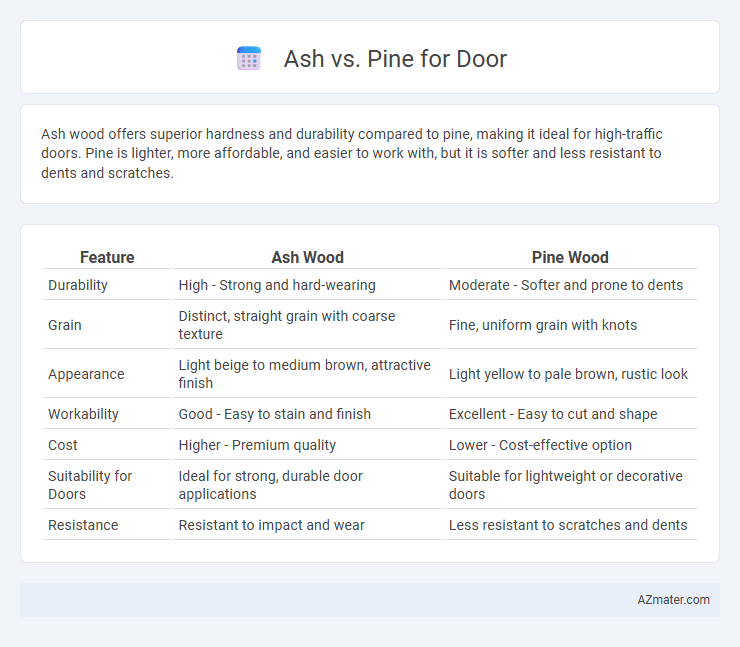Ash wood offers superior hardness and durability compared to pine, making it ideal for high-traffic doors. Pine is lighter, more affordable, and easier to work with, but it is softer and less resistant to dents and scratches.
Table of Comparison
| Feature | Ash Wood | Pine Wood |
|---|---|---|
| Durability | High - Strong and hard-wearing | Moderate - Softer and prone to dents |
| Grain | Distinct, straight grain with coarse texture | Fine, uniform grain with knots |
| Appearance | Light beige to medium brown, attractive finish | Light yellow to pale brown, rustic look |
| Workability | Good - Easy to stain and finish | Excellent - Easy to cut and shape |
| Cost | Higher - Premium quality | Lower - Cost-effective option |
| Suitability for Doors | Ideal for strong, durable door applications | Suitable for lightweight or decorative doors |
| Resistance | Resistant to impact and wear | Less resistant to scratches and dents |
Introduction to Ash and Pine for Doors
Ash wood is renowned for its strength, durability, and attractive grain, making it a popular choice for doors that require both aesthetic appeal and resilience. Pine, a softer and lighter wood, offers affordability and ease of customization, often used in interior doors where weight and cost are considerations. Both ash and pine provide distinct benefits depending on the desired door characteristics and installation environment.
Appearance and Grain Patterns
Ash wood exhibits a light, creamy color with pronounced, straight grain patterns that create a bold and contemporary look for doors. Pine features a softer, yellowish tone with more knotty, irregular grain textures, offering a rustic and warm aesthetic. The distinct contrast between Ash's sleek, uniform grain and Pine's natural, varied pattern allows for versatile design choices in door appearances.
Strength and Durability Comparison
Ash wood is known for its exceptional strength and shock resistance, making it a highly durable choice for doors subjected to frequent use and impact. Pine, while more affordable and easier to work with, is softer and less resilient, making it more prone to dents and wear over time. The dense grain structure of ash contributes to its superior load-bearing capacity and long-lasting durability compared to the lighter, less dense pine.
Cost Differences Between Ash and Pine
Ash doors typically cost more than pine doors due to the wood's density, durability, and aesthetic appeal, making it a premium choice for high-quality finishes. Pine is more affordable, widely available, and easier to work with, but it may lack the hardness and longevity of ash. When budgeting for doors, consider that ash's higher initial investment can result in better long-term value through increased resistance to wear and tear.
Workability and Ease of Installation
Ash offers superior workability due to its straight grain and moderate hardness, allowing for smooth cutting, sanding, and machining, which simplifies door crafting and fitting. Pine is softer and lighter, making it easier to handle and install, but it may require more care to avoid dents and damage during installation. Both woods suit door applications, yet Ash provides a balance of durability and ease of shaping, while Pine excels in ease of installation and cost efficiency.
Maintenance and Longevity
Ash doors offer excellent durability with moderate maintenance, requiring occasional sealing or varnishing to protect against moisture and wear. Pine doors demand more frequent upkeep due to their softer wood, needing regular painting or staining to prevent dents and decay. Both woods provide long-lasting solutions, but ash doors typically outlast pine when properly maintained.
Environmental Impact and Sustainability
Ash wood is a sustainable choice for doors due to its fast growth rate and abundance, reducing pressure on natural forests. Pine is also environmentally friendly, as it is widely available and typically harvested from managed plantations promoting forest regeneration. Both woods have low embodied energy compared to synthetic materials, enhancing their appeal for eco-conscious construction.
Suitability for Different Interior Styles
Ash wood offers a light, creamy color with pronounced grain patterns that complement Scandinavian, modern, and rustic interiors by adding natural warmth and texture. Pine features a softer, paler tone with knots that suit cottage, farmhouse, and country-style doors, providing a relaxed and cozy ambiance. Both woods are versatile, but ash is preferred for sleek, contemporary designs while pine enhances casual, traditional aesthetics.
Resistance to Weather and Insects
Ash wood offers moderate resistance to weather elements but requires regular sealing to prevent moisture damage, making it less durable in outdoor door applications without proper maintenance. Pine is more susceptible to insect infestations and weathering, often needing chemical treatments to enhance its durability for exterior use. Choosing ash over pine for doors provides better resilience against environmental factors but demands consistent upkeep for optimal protection.
Conclusion: Which is Better for Doors?
Ash offers superior hardness and durability, making it ideal for high-traffic areas where strength is crucial. Pine, while softer and more affordable, provides excellent workability and is suitable for decorative or interior doors with less wear. For door applications demanding long-term resilience and resistance to impact, ash is the better choice.

Infographic: Ash vs Pine for Door
 azmater.com
azmater.com